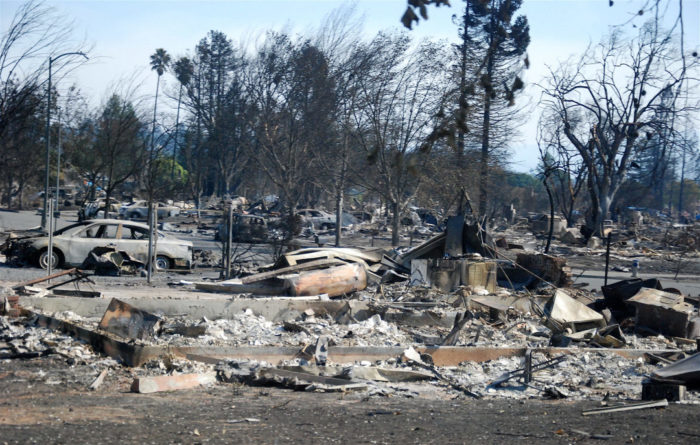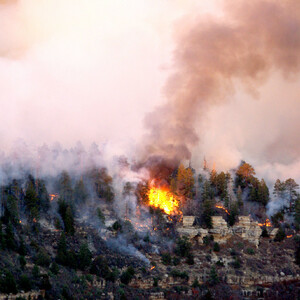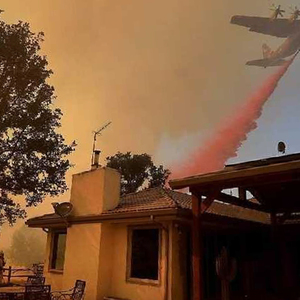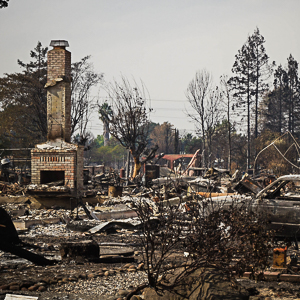
Image Credit: California National Guard via Flickr
By Clare Trapasso, realtor.com.
Late Sunday evening, Russel Lee was relaxing on his deck in Santa Rosa, California, drinking a glass of wine. Then he smelled the smoke. He checked the local police scanner app on his phone and learned that wildfires blazing out of control were moving in on his four-bedroom townhouse in Northern California’s Sonoma County.
The 63-year-old real estate agent and his wife, an artist, dug out their three cat carriers and frantically began packing some clothes, valuables, and important paperwork. At around 1 a.m., the police came banging on the door, yelling: “Get out now!” The Lees made it to a makeshift emergency shelter at the local veterans center, along with some folks who hadn’t had time to change out of their bathrobes and slippers before fleeing.
Their home was burned to rubble, and they lost nearly everything — including one of their beloved cats, Alya, who refused to get into her carrier in time. His wife’s artwork, much of which she had already sold online, was all destroyed along with the antique furniture that had been in his family for generations. The couple are now living in their motor home parked on their friend’s driveway.
But despite their devastating losses, Lee and his wife know they were lucky.
Forty-two people have died in the wildfires burning through seven counties, including the famed wine-producing areas of Napa and Sonoma, as of October 18, according to The Los Angeles Times. About 3,500 homes and buildings have been incinerated by the blazes, which have ravaged about 170,000 acres, mostly in Northern California. (That’s larger than the island of Manhattan.) The causes of the fires have not yet been established.
The region will struggle for years
As firefighters struggle to contain the conflagrations in the wine country north of San Francisco, it is clear that the region, an economic powerhouse for California, will continue to suffer long after the flames are extinguished and the human toll has been counted.
The disaster is expected to ravage the housing markets of this highly prosperous region, with slashed prices, scarce availability, and wrecked infrastructure — all factors that will need to be taken into account as displaced homeowners decide whether to return and rebuild, or leave the area for good. The multibillion-dollar tourist industry, and the jobs it provides, is also at risk. It’s likely to take up to a decade to rebuild the homes, businesses, and essential services such as schools residents will need should they choose to return.
Wildfires are common in California, as well as the Western states of Washington, Oregon, and Colorado, in late summer and fall. But those burning in Northern California are unusual, says Tom Jeffery, a senior hazard scientist at CoreLogic, a real estate information company.
“When you have a wildfire occur in an area that’s uninhabited, it can be a good thing for the environment. You have to have fires to have certain plants [like certain pine species] to reproduce,” he says. “[But] whenever you have homes exposed to it, then you have a potential disaster.”
The median home price in Napa County was a whopping $876,200 on September 1, according to realtor.com data. In neighboring Sonoma County, the median home price was $750,000. But that was before the fires.
More than 172,000 homes are now at risk of going up in flames in the Napa and Santa Rosa metropolitan areas, which are usually not prone to wildfires, according to an analysis from CoreLogic. (Napa is the name of a town as well as of the surrounding county.) It will cost an estimated $65 billion or more to rebuild them.
A “charred-to-the-ground moonscape”
Californians are just beginning to come to grips with the scope of the disaster.
“Multiple neighborhoods are burnt out,” says Randall Bell, CEO of the national real estate appraisal firm Landmark Research Group, based in Laguna Beach, California, which has assessed areas damaged by wildfires. “It’s street upon street of just charred-to-the-ground moonscape. All you see are chimneys and foundations. It’s a sad sight — and you see hundreds of them.”
What will happen to the housing markets once the wildfires are extinguished?
Only about a quarter to half of the original residents whose homes were reduced to ash are likely to return and rebuild, Bell predicts.
“Emotionally they’re overwhelmed. Financially, they’re overwhelmed,” he says. “When these fires come through, they don’t just burn houses. They burn stores, restaurants, the churches, the schools. They burn everything. You may rebuild a house, but where’s your infrastructure?”
Lee, the real estate agent whose Santa Rosa home burned down, doesn’t plan to rebuild. He and his wife plan to move to Kentucky, Tennessee, or North Carolina, where they have friends who might be able to find him work.
“I’ve started an insurance claim and hopefully I’ll do well. … [But] I’m a real estate agent and there’s nothing to sell anymore,” he says. “I’m starting over from scratch at 63 with achy joints and an achy back.”
Even homeowners with insurance premiums may not get enough money to rebuild their entire homes to what they were before, Bell says. That’s because the price of construction is likely to skyrocket with the extra demand for construction workers, for which there is currently a national shortage compounded by Hurricanes Harvey and Irma, and building materials. Some will get loans, others will tap into their savings.
Those who do rebuild are in for the long haul. The area is expected to recover only about 10% to 15% each year, according to Bell. That means it’s likely to take five to 10 years before homes, businesses (including employment and tourism), and the local infrastructure is back to normal.
An existing housing crisis won’t help
Plus, they’ll have to find a place to live while they rebuild — which won’t be an easy feat.
“We had a housing crisis before the fire,” says Santa Rosa-based Realtor Daphne Peterson, of Keller Williams Realty. “We’re in a very high-cost area. Our vacancy rate was about 1%. Now we’ve lost about 1,500 to 2,000 homes. We have no place for people to stay.”
Homeowners who decide to sell won’t have it easy, either. Those whose homes survived should expect the properties to sell at a 10% to 35% discount. That’s because it’s not as desirable to live near burnt-out houses or with fewer services and businesses nearby.
“People don’t buy a house,” Bell says. “They buy a neighborhood.”
Meanwhile, properties whose homes were charred or destroyed altogether could see discounts as high as 60%, he says. Sellers should expect an army of investors, a combination of home flippers and landlords, to swoop in.
But the price breaks won’t last forever. These will likely dissipate after about five years, he says.
“I know that it will all come back,” says Sonoma-area Realtor David Kerr, of Terra Firma Global Partners. “People in the North Bay are resilient. They will get through this.” But he worries about the farmhands at the vineyards and the other residents or workers who aren’t quite so well off. “It’s not going to be easy for [everybody].”
Clare Trapasso is senior news editor at realtor.com. Reprinted from realtor.com.
Weekly Newsletter
Get building science and energy efficiency advice, plus special offers, in your inbox.














2 Comments
What about rebuilding with fire resistant structures?
What about rebuilding with fire resistant structures (ICF, steel) and also mandating defensible space around the homes?
It would be a shame to rebuild again with standard wood framing practices, only to have this happen again years or decades later.
Non-combustible stucco, ICF concrete walls, metal roofs and defensible space goes a long way in preventing wildfires from destroying homes.
Response to Peter L.
Good comments Peter however I would suggest it needs to go beyond in that many houses that burned to the ground had metal roofs and stucco finishes but the intensity of the winds and the fire caused most houses to burn from the inside out (wood framing is a problem in this instance), leaving the plaster finishes somewhat intact and laying on the ground along with piles of clay tiles on the ground. No clear answers biut it definitely should be addressed. Thanks very much.
Log in or create an account to post a comment.
Sign up Log in